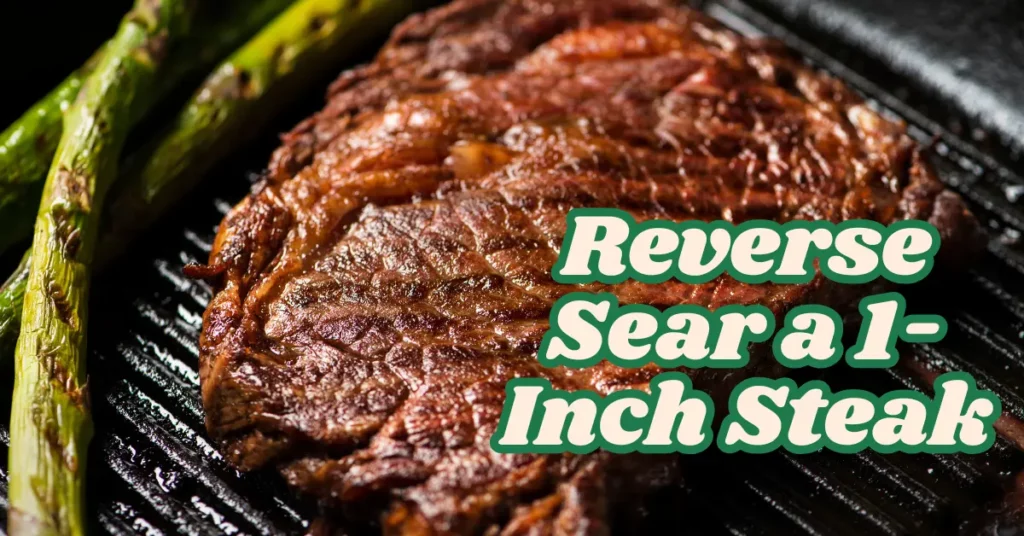This post may contain affiliate links. If you use these links to buy something we may earn a small commission. Thanks.
If you’re someone who appreciates a perfectly cooked steak crispy on the outside, juicy and tender on the inside then you’ve likely heard about the reverse sear technique. This method has gained popularity among chefs and home cooks alike, offering an alternative to the traditional sear-first approach. But when it comes to thinner cuts, like a 1-inch steak, many wonder: how long does it actually take to reverse sear it without overcooking?
In this detailed guide, we’ll walk you through everything you need to know about reverse searing a 1-inch steak, from prep to perfection. Whether you’re using a ribeye, sirloin, strip, or filet, this technique can help elevate your steak game to the next level.

What Is Reverse Searing?
Reverse searing flips the traditional method of cooking steak on its head. Instead of searing the steak first and then finishing it in the oven, you start by slowly cooking the steak at a low temperature usually in the oven or a smoker and then finish it with a high-heat sear on a skillet or grill.
Why Reverse Sear Works
- Even Doneness: Gently cooking the steak helps it cook uniformly from edge to center.
- Perfect Crust: The final sear gives that restaurant-quality golden brown crust.
- Juicy Interior: Since the steak cooks slowly, it retains more moisture.
This technique is especially loved for thick steaks, but with the right timing and care, you can absolutely apply it to a 1-inch steak for great results.
Is a 1-Inch Steak Ideal for Reverse Searing?
Traditionally, reverse searing is best suited for steaks that are at least 1.5 to 2 inches thick, simply because there’s more margin for error. Thicker cuts allow more flexibility in internal temperature buildup without overcooking the exterior.
However, that doesn’t mean you can’t reverse sear a 1-inch steak. You just need to pay closer attention to timing and internal temperature. The key is not to overdo the oven phase, as thinner steaks reach target temperatures much faster.
Preparing the Steak for Reverse Sear
Before we jump into the timing, let’s cover the essential prep steps to ensure your steak turns out flawless.
1. Choose the Right Cut
Almost any steak can be reverse seared, including:
- Ribeye
- New York Strip
- Filet Mignon
- Sirloin
Just make sure your steak is at least 1 inch thick.
2. Bring the Steak to Room Temperature
Let your steak sit out for 20–30 minutes before cooking. This helps it cook evenly and reduces the risk of cold spots.
3. Season Generously
Salt and freshly ground black pepper are must-haves. You can also add garlic powder, rosemary, thyme, or even dry brine your steak by salting it a few hours ahead.
4. Dry the Surface
Pat your steak dry with a paper towel. This promotes better browning during the searing phase.
How to Reverse Sear a 1-Inch Steak: Step-by-Step
Now, let’s get into the actual method. Here’s how to reverse sear a 1-inch steak like a pro:
Step 1: Preheat the Oven
Set your oven to 225°F to 275°F. The lower the temperature, the more gentle and even the cook, but the longer it takes. For 1-inch steaks, 250°F is a good balance.
Step 2: Prepare Your Baking Setup
Place the steak on a wire rack over a baking sheet. This setup ensures hot air circulates evenly around the steak, promoting uniform cooking.
Step 3: Slow Roast in Oven
Insert a meat thermometer into the thickest part of the steak. Your goal is to reach:
- 110°F to 115°F for Medium-Rare
- 115°F to 120°F for Medium
This typically takes 20–30 minutes in a 250°F oven for a 1-inch steak. If your oven is hotter, it might take only 15–20 minutes so keep a close eye.
Step 4: Rest Before Searing
After removing the steak from the oven, let it rest for 5–10 minutes. This allows juices to redistribute and ensures a better sear without overcooking.
Step 5: High-Heat Sear
Now it’s time for the magic.
- Heat a cast iron skillet or grill over high heat until it’s smoking hot.
- Add a bit of oil with a high smoke point (like avocado or canola).
- Sear the steak for 45 seconds to 1 minute per side.
- Optionally, add butter, smashed garlic, and fresh herbs during the sear to baste and boost flavor.
- Don’t forget to sear the edges briefly as well.
Internal Temperature Guide for Perfect Doneness
Here’s a quick reference chart to help you hit your desired level of doneness:
| Doneness | Internal Temp (Before Searing) | Final Temp (After Searing) |
|---|---|---|
| Rare | 105°F–110°F | 120°F–125°F |
| Medium-Rare | 110°F–115°F | 130°F–135°F |
| Medium | 115°F–120°F | 135°F–145°F |
| Medium-Well | 120°F–125°F | 145°F–155°F |
| Well Done | 130°F+ | 160°F+ |
Note: Carryover heat from searing will increase internal temperature by 5–10°F.
Total Time Summary: Reverse Sear for 1-Inch Steak
Let’s put all the timings together:
- Oven Cook Time: 20–30 minutes
- Resting Time (Pre-Sear): 5–10 minutes
- Searing Time: 2–3 minutes total
- Optional Resting Time (Post-Sear): 5 minutes
Total Time: ~30 to 45 minutes
That’s all it takes to enjoy steakhouse-quality flavor and texture from your own kitchen.
Tips for Perfect Reverse Sear on 1-Inch Steak
- Use a digital meat thermometer. It’s the most accurate way to avoid overcooking.
- Don’t skip the rest time before searing. It helps retain juices and allows even surface drying for a better crust.
- Always dry the surface thoroughly before searing to avoid steaming.
- Sear on a hot surface only. Lukewarm pans won’t create the Maillard reaction needed for crust development.
- Finish with a pat of butter or pan sauce. This adds a luxurious touch to your steak.
Common Mistakes to Avoid
- Starting with a cold steak: It will cook unevenly and reduce the effectiveness of reverse searing.
- Cooking too long in the oven: Thinner steaks overcook quickly—always monitor internal temp.
- Skipping the sear: You’ll miss out on flavor and texture.
- Not using a wire rack in the oven: This can cause soggy bottom surfaces and uneven cooking.
- Searing for too long: You risk overcooking the steak after the internal temp is already at your target range.
Final Thoughts
Reverse searing a 1-inch steak may seem tricky at first, but it’s completely doable with careful timing and the right techniques. While it’s true that thicker cuts are more forgiving, even a modest 1-inch steak can be transformed into a flavor-packed, perfectly cooked masterpiece with this method.
The key takeaway? Monitor your internal temperature closely, don’t rush the process, and let the sear bring it all home. Once you get the hang of it, reverse searing may just become your go-to method for cooking steaks regardless of thickness.
So go ahead fire up your oven, grab your thermometer, and give your next steak the love it deserves.
